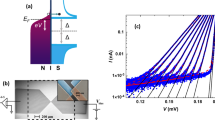Abstract
The thermal conductivity in bulk samples of pure Zn and the Kondo alloy Zn-Mn have been measured in the temperature range 0.360 to about 1.0 K for concentrations 2.7, 6.0, 8.4, 10.0, and 11.7 ppm Mn. Our results for the depression of the superconducting to normal state transition temperature (T c) with Mn concentration and for the temperature dependence of the thermal conductivity of pure Zn agree with the results obtained by other workers. The ratio of the thermal conductances in the superconducting and normal states has been quantitatively compared with the Bardeen-Rickayzen-Tewordt and Ambegaokar-Griffin theories. We found agreement between the Ambegaokar-Griffin theory and experiment at all temperatures for Mn concentrations lower than 10.0 ppm and discrepancy between theory and experiment in the 10.0 ppm and 11.7-ppm samples. In the latter specimens the measured conductance ratio was greater than the theoretical predictions. For these two samplesT c occurs at about the temperature where ordering (impurity-impurity interactions) is observed in the normal state. We have analyzed our measurements using those solutions of the Kondo problem in superconductors dealing mainly with the existence of bound states in the energy gap, as well as available theories on the effects of impurity-impurity interactions. We have concluded that our results can be qualitatively understood using the ideas of Fowler and Maki and of Zittartz and Müller-Hartmann which give a bound state in the energy gap. It appears that the growth of the impurity band and spin ordering (impurity-impurity interactions) are intrinsically related.
Similar content being viewed by others
References
F. W. Smith,J. Low Temp. Phys. 5, 683 (1971).
R. S. Newrock, B. Serin, J. Vig, and G. Boato,J. Low Temp. Phys. 5, 701 (1971).
M. Fowler and K. Maki,Phys. Rev. B 1, 181 (1970).
J. Zittartz and E. Müller-Hartmann,Z. Physik 232, 11 (1970).
E. Müller-Hartmann and J. Zittartz,Z. Physik 234, 58 (1970).
J. Zittartz and E. Müller-Hartmann,Z. Physik 237, 419 (1970).
E. Müller-Hartmann and J. Zittartz,Phys. Rev. Letters 26, 428 (1971).
J. D. Marsh,Phys. Letters 33A, 207 (1970).
G. Boato, M. Bugo, and C. Rizzuto,Nuovo Cimento 45, 226 (1966).
G. Boato, G. Gallinaro, and C. Rizzuto,Rev. Mod. Phys. 36, 162 (1964);Phys. Rev. 148, 353 (1966).
S. Y. Hsieh and D. H. Sánchez, “Calibration of Germaniun Thermometers between 0.080 K and 4.2K,” Rutgers University (available on request from the authors).
J. F. Cochran, C. A. Schiffman, and J. F. Neighbor,Rev. Sci. Instr. 37, 499 (1966).
R. Soulen, PhD. Thesis, Rutgers University (1966).
W. Worobey, PhD. Thesis, Rutgers University (1965).
T. B. Greenslade, PhD. Thesis, Rutgers University (1966).
A. C. Anderson,Rev. Sci. Instr. 40, 1502 (1969).
J. C. Wheatley, O. E. Vilches, and W. R. Abel,Physics 4, 1 (1968).
J. M. Costignola, F. de la Cruz, M. E. de la Cruz, and R. P. Platzeck,Rev. Sci. Instr. 38, 87 (1967).
Y. Muto, Y. Tawara, Y. Shibuya, and T. Fukuroi,J. Phys. Soc. Japan 14, 380 (1959). Y. Muto,Sci. Repts. Tohoku Univ., First Series 13, 1 (1961).
N. V. Zavaritskii,Zh. Eksperim. i Teor. Fiz. 34, 1116 (1958) [English transl.,Soviet Phys.— JETP 7, 773 (1958)];Zh. Eksperim. i Teor. Fiz. 39, 1193 (1960) [English transl.,Soviet Phys.—JETP 12, 831 (1961)].
C. Kittel,Introduction to Solid State Physics (Wiley, New York, 1966), p. 222.
J. Bardeen, G. Rickayzen, and L. Tewordt,Phys. Rev. 113, 982 (1959).
E. D. Ramos and D. H. Sánchez, “Tabulation of the BRT function for the thermal conductivity and the AG function for the depression ofT c,” Rutgers University (available on request from the authors; a short version is inCryogenics 14, 341 (1974)).
J. Bardeen, L. N. Cooper, and J. R. Schrieffer,Phys. Rev. 108, 1175 (1957).
V. Ambegaokar and A. Griffin,Phys. Rev. 137, A1151 (1965).
A. A. Abrikosov and L. P. Gor'kov,Zh. Eksperim. i Teor. Fiz. 39, 1781 (1960) [English transl.,Soviet Phys.—JETP 12, 1243 (1961)]
E. A. Lynton,Superconductivity (Methuen, London, 1962), pp. 93, 125.
R. Meservey and B. B. Schwartz,Superconductivity, R. D. Parks, ed. (Marcel Dekker, New York, 1969), Vol. 1, p. 141.
R. D. Parks, inProc. McGill Advanced Summer Study Institute on Superconductivity, June 1968, P. R. Wallace, ed. (Gordon and Breach, New York, 1969), Vol. 2, p. 623.
K. H. Bennemann and F. M. Mueller,Phys. Rev. 176, 546 (1968).
W. R. Decker and D. K. Finnemore,Phys. Rev. 172, 430 (1968).
Author information
Authors and Affiliations
Additional information
This work has been submitted as partial fulfillment for the degree of Doctor of Philosophy at Rutgers University.
Rights and permissions
About this article
Cite this article
Sánchez, D.H. Thermal conductivity of the Kondo superconductor Zn-Mn. J Low Temp Phys 17, 101–120 (1974). https://doi.org/10.1007/BF00654547
Received:
Issue Date:
DOI: https://doi.org/10.1007/BF00654547




